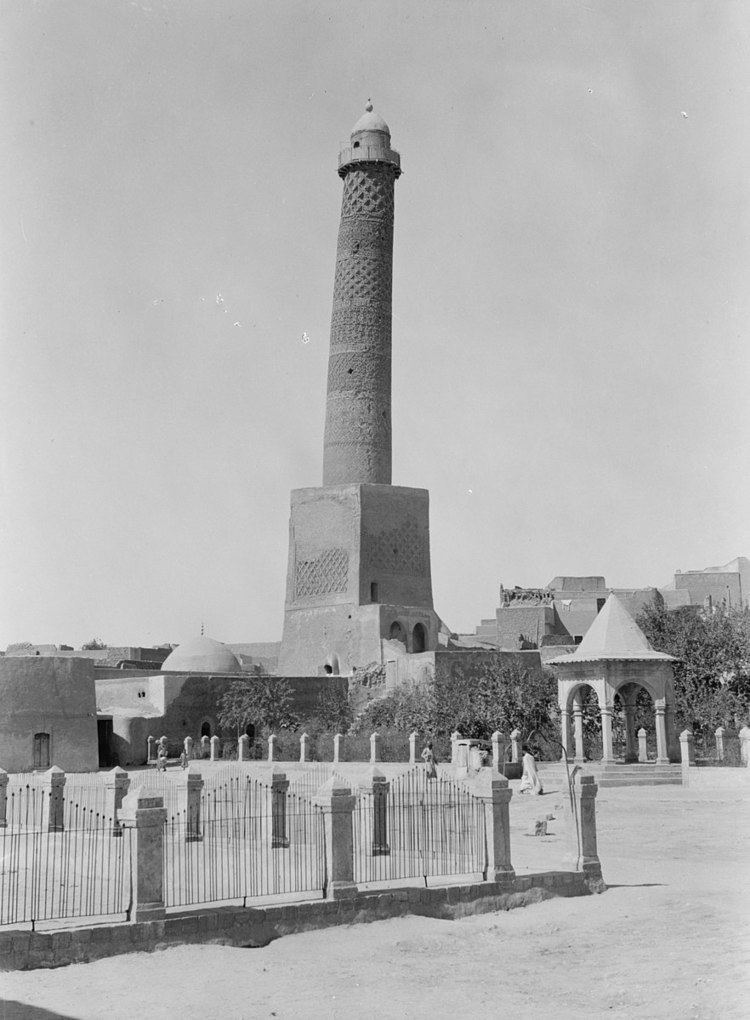Location Mosul Minaret height 45 metres (148 ft) | Affiliation Sunni Islam Year consecrated 1172 | |
 | ||
Address Al Shaziani St, Mosul, Iraq Similar Mosques and shrines of, Bash Tapia Castle, Mudhafaria Minaret, جامع ابو دلف, Nur al‑Din Mosque | ||
Great mosque of al nuri mosul
The Great Mosque of al-Nuri (جامع النوري) is a historical mosque in Mosul, Iraq famous for its leaning minaret which gave the city its nickname "the hunchback" (الحدباء al-Ḥadbāˈ).
Contents
Construction
Tradition holds that Nur ad-Din Zangi built the mosque in 1172-73, shortly before his death. According to the chronicle of Ibn al-Athir, after Nur ad-Din took control of Mosul he ordered his nephew Fakhr al-Din to build the mosque:
[Nur ad-Din] rode in person to its site and viewed it. He climbed the minaret of the mosque of Abu Hadir, looked down on the site of his mosque and ordered that the neighbouring houses and shops should be added to the land that he viewed but that nothing should be taken without the willing agreement of the owners. He put the Sheikh Umar al-Malla in charge of the project, a pious and good man. The properties were purchased from their owners at most substantial prices and the construction began, on which large sums were expended. The building was completed in the year 568 [i.e. AD 1172-3].
In 1511, this mosque was extensively renovated by the Safavid Empire.
Minaret
The mosque is well known for its leaning minaret, known as al-Hadba’ ("the hunchback"). Grattan Geary, a 19th-century traveler, described the minaret's appearance:
It is several feet out of the perpendicular, though it starts fair from the ground, and at the top, before putting on its gallery and dome, it regains an erect posture. Its attitude is that of a man bowing.
When the cylindrical minaret was built it stood 45 metres (148 ft) high, with seven bands of decorative brickwork in complex geometric patterns ascending in levels towards the top. By the time the traveler Ibn Battuta visited in the 14th century it was already listing and had acquired its nickname. The design of the minaret follows a form originally developed in neighboring Iran and Central Asia and shares similarities with other minarets in northern Iraq, such as those in Mardin, Sinjar and Arbil.
According to local tradition (which resolutely ignores chronology), the minaret gained its tilt after the Prophet Muhammad passed overhead while ascending to heaven. The minaret bowed itself in reverence but could only regain its balance after its top joint had been kinked in the opposite direction. According to local Christian tradition, however, the mosque's tilt was due to its bowing towards the tomb of the Virgin Mary, reputedly located near Arbil.
Current situation
Both the mosque and its madrasa were dismantled and reassembled in 1942 in a restoration programme undertaken by the Iraqi government. The minaret has remained unrestored, although attempts were made in 1981 by an Italian firm to stabilise it. However, the bombing of Mosul during the Iran–Iraq War broke underground pipes and caused leaks under the minaret that further undermined it. The lean has worsened by another 40 centimetres (16 in) since then. The cause of the lean is disputed – some have blamed the prevailing wind – but local officials have attributed it to the effects of thermal expansion caused by the heat of the sun, causing bricks on the sun-facing side to expand and progressively tilt the minaret. In recent years cracks have proliferated along the base of the minaret, which now leans nearly 3 metres (9.8 ft) off the vertical. It has been listed by the World Monuments Fund as a site of concern due to the ongoing risk of collapse.
The structure was targeted by ISIS militants who occupied Mosul on June 10, 2014 and previously destroyed the Tomb of Jonah. However residents of Mosul incensed with the destruction of their cultural sites protected the mosque by forming a human chain and forming a resistance against ISIS.
Allegedly, Abu Bakr al-Baghdadi appeared during a Friday prayer in this mosque in 2014.
